KLA249: Industry Analysis and Adoption: Cape Grim Beef Study
VerifiedAdded on 2022/10/11
|23
|6629
|15
Report
AI Summary
This report provides a comprehensive analysis of the Australian beef industry, with a specific focus on Cape Grim Beef. It begins with an executive summary and introduction to the industry, highlighting Cape Grim's position as a major player. The core of the report utilizes the PESTLE framework to analyze the political, economic, social, technological, legal, and environmental factors influencing the industry. The political analysis covers free trade agreements and live trade regulations, while the economic section examines market dynamics, supply and demand, and exchange rate fluctuations. Social factors include public perceptions of grain-fed versus grass-fed beef, attitudes towards live exports, vegetarianism, and ethical treatment of animals. Technological aspects discussed include animal identification tags, animal feed and nutrient planning, and breeding technologies. Legal and environmental considerations are also addressed. The report then includes a communication plan, detailing situation analysis, target audience profiling, key stakeholders, and key messages. Finally, it concludes with recommendations and strategies for Cape Grim Beef, along with references and appendices.
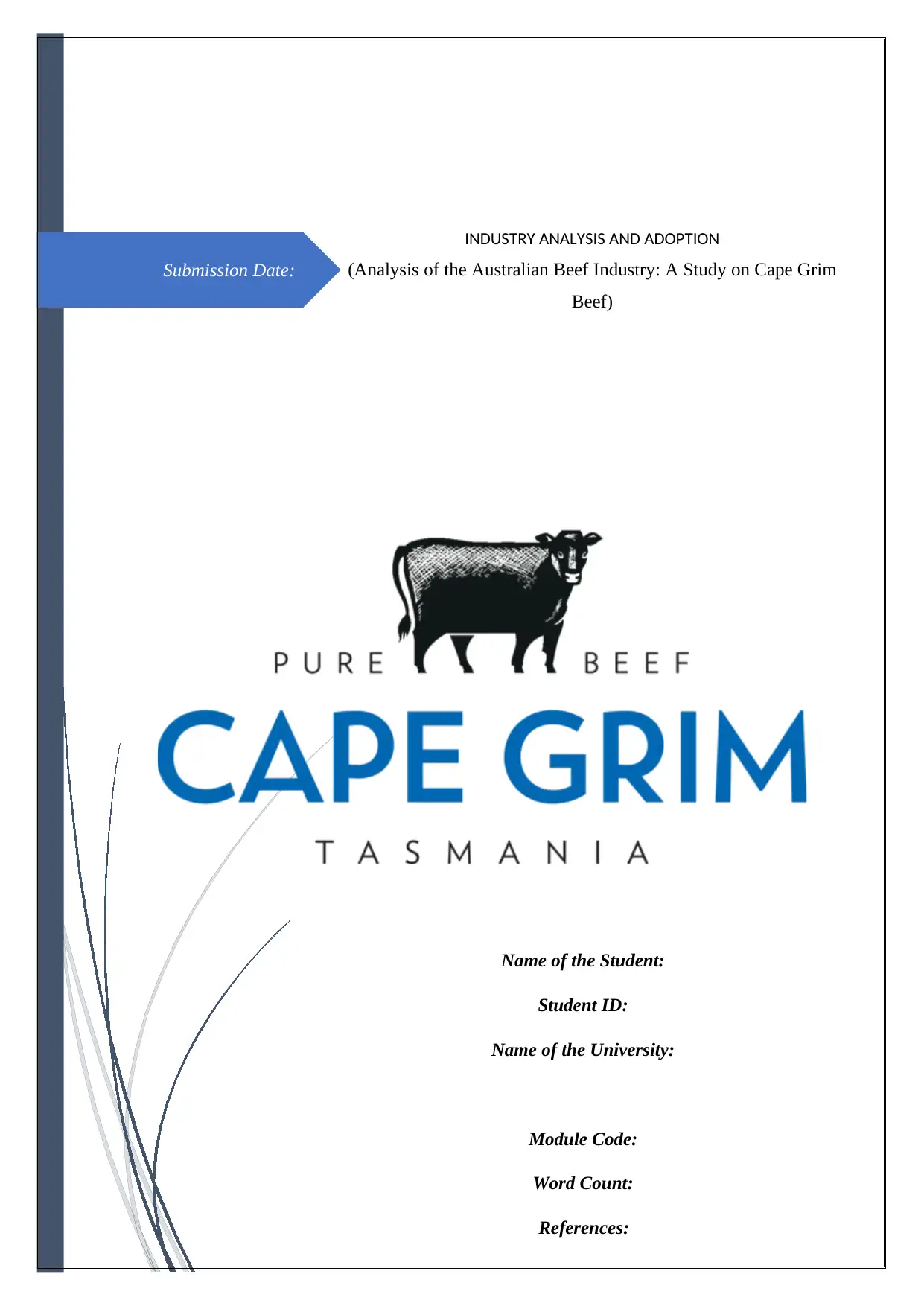
Submission Date:
INDUSTRY ANALYSIS AND ADOPTION
(Analysis of the Australian Beef Industry: A Study on Cape Grim
Beef)
Name of the Student:
Student ID:
Name of the University:
Module Code:
Word Count:
References:
INDUSTRY ANALYSIS AND ADOPTION
(Analysis of the Australian Beef Industry: A Study on Cape Grim
Beef)
Name of the Student:
Student ID:
Name of the University:
Module Code:
Word Count:
References:
Paraphrase This Document
Need a fresh take? Get an instant paraphrase of this document with our AI Paraphraser
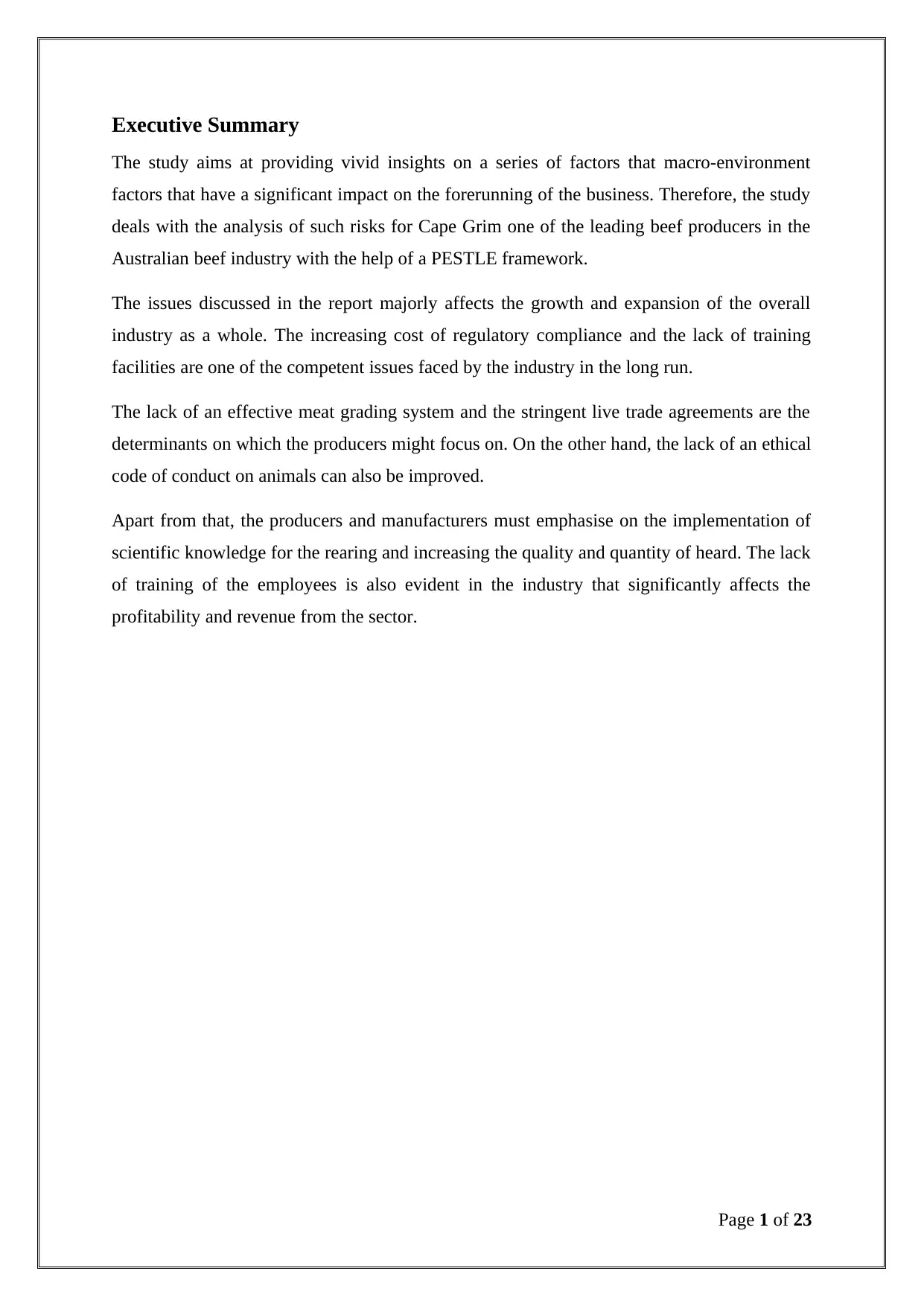
Executive Summary
The study aims at providing vivid insights on a series of factors that macro-environment
factors that have a significant impact on the forerunning of the business. Therefore, the study
deals with the analysis of such risks for Cape Grim one of the leading beef producers in the
Australian beef industry with the help of a PESTLE framework.
The issues discussed in the report majorly affects the growth and expansion of the overall
industry as a whole. The increasing cost of regulatory compliance and the lack of training
facilities are one of the competent issues faced by the industry in the long run.
The lack of an effective meat grading system and the stringent live trade agreements are the
determinants on which the producers might focus on. On the other hand, the lack of an ethical
code of conduct on animals can also be improved.
Apart from that, the producers and manufacturers must emphasise on the implementation of
scientific knowledge for the rearing and increasing the quality and quantity of heard. The lack
of training of the employees is also evident in the industry that significantly affects the
profitability and revenue from the sector.
Page 1 of 23
The study aims at providing vivid insights on a series of factors that macro-environment
factors that have a significant impact on the forerunning of the business. Therefore, the study
deals with the analysis of such risks for Cape Grim one of the leading beef producers in the
Australian beef industry with the help of a PESTLE framework.
The issues discussed in the report majorly affects the growth and expansion of the overall
industry as a whole. The increasing cost of regulatory compliance and the lack of training
facilities are one of the competent issues faced by the industry in the long run.
The lack of an effective meat grading system and the stringent live trade agreements are the
determinants on which the producers might focus on. On the other hand, the lack of an ethical
code of conduct on animals can also be improved.
Apart from that, the producers and manufacturers must emphasise on the implementation of
scientific knowledge for the rearing and increasing the quality and quantity of heard. The lack
of training of the employees is also evident in the industry that significantly affects the
profitability and revenue from the sector.
Page 1 of 23
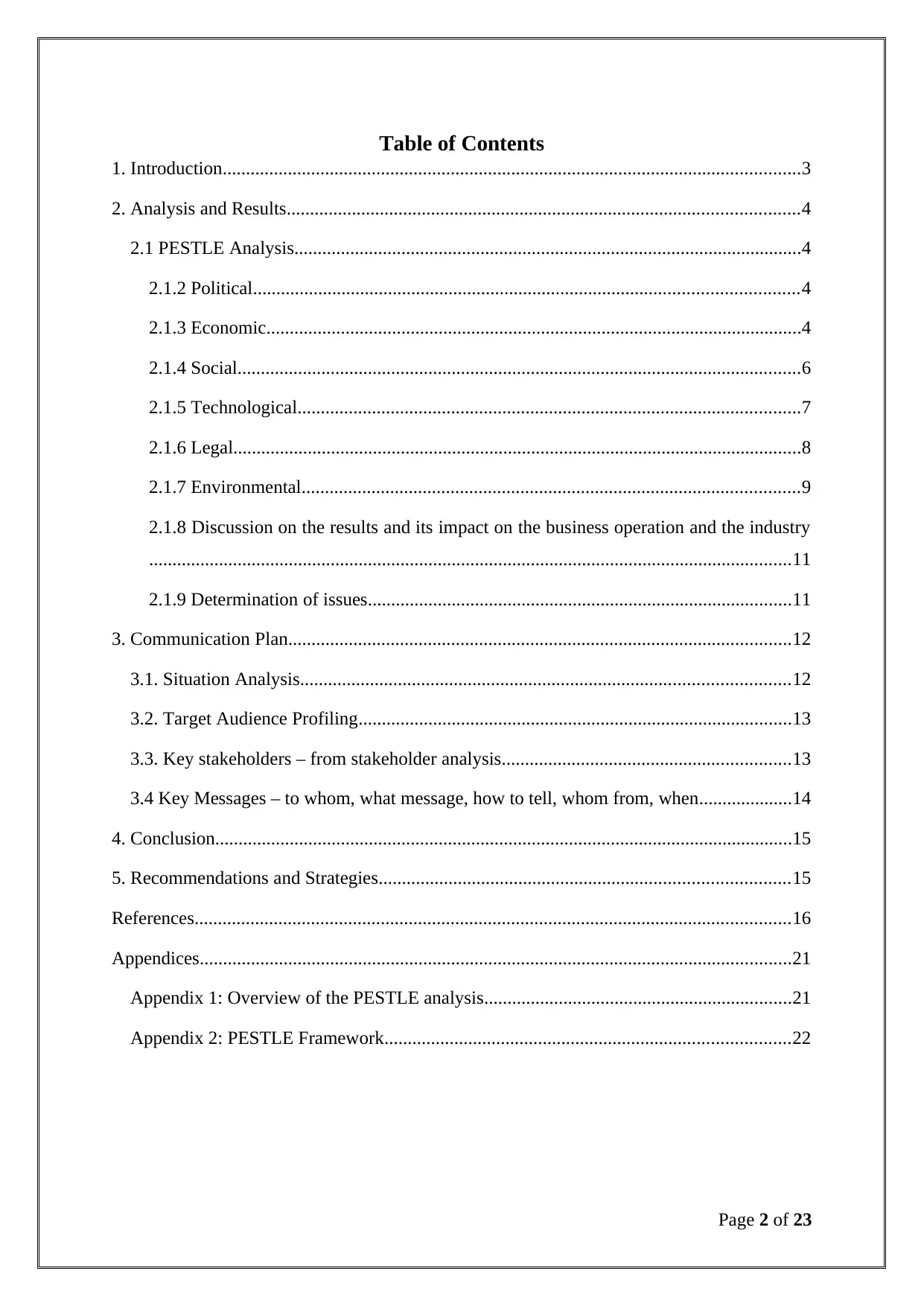
Table of Contents
1. Introduction............................................................................................................................3
2. Analysis and Results..............................................................................................................4
2.1 PESTLE Analysis.............................................................................................................4
2.1.2 Political.....................................................................................................................4
2.1.3 Economic...................................................................................................................4
2.1.4 Social.........................................................................................................................6
2.1.5 Technological............................................................................................................7
2.1.6 Legal..........................................................................................................................8
2.1.7 Environmental...........................................................................................................9
2.1.8 Discussion on the results and its impact on the business operation and the industry
..........................................................................................................................................11
2.1.9 Determination of issues...........................................................................................11
3. Communication Plan............................................................................................................12
3.1. Situation Analysis.........................................................................................................12
3.2. Target Audience Profiling.............................................................................................13
3.3. Key stakeholders – from stakeholder analysis..............................................................13
3.4 Key Messages – to whom, what message, how to tell, whom from, when....................14
4. Conclusion............................................................................................................................15
5. Recommendations and Strategies........................................................................................15
References................................................................................................................................16
Appendices...............................................................................................................................21
Appendix 1: Overview of the PESTLE analysis..................................................................21
Appendix 2: PESTLE Framework.......................................................................................22
Page 2 of 23
1. Introduction............................................................................................................................3
2. Analysis and Results..............................................................................................................4
2.1 PESTLE Analysis.............................................................................................................4
2.1.2 Political.....................................................................................................................4
2.1.3 Economic...................................................................................................................4
2.1.4 Social.........................................................................................................................6
2.1.5 Technological............................................................................................................7
2.1.6 Legal..........................................................................................................................8
2.1.7 Environmental...........................................................................................................9
2.1.8 Discussion on the results and its impact on the business operation and the industry
..........................................................................................................................................11
2.1.9 Determination of issues...........................................................................................11
3. Communication Plan............................................................................................................12
3.1. Situation Analysis.........................................................................................................12
3.2. Target Audience Profiling.............................................................................................13
3.3. Key stakeholders – from stakeholder analysis..............................................................13
3.4 Key Messages – to whom, what message, how to tell, whom from, when....................14
4. Conclusion............................................................................................................................15
5. Recommendations and Strategies........................................................................................15
References................................................................................................................................16
Appendices...............................................................................................................................21
Appendix 1: Overview of the PESTLE analysis..................................................................21
Appendix 2: PESTLE Framework.......................................................................................22
Page 2 of 23
⊘ This is a preview!⊘
Do you want full access?
Subscribe today to unlock all pages.

Trusted by 1+ million students worldwide
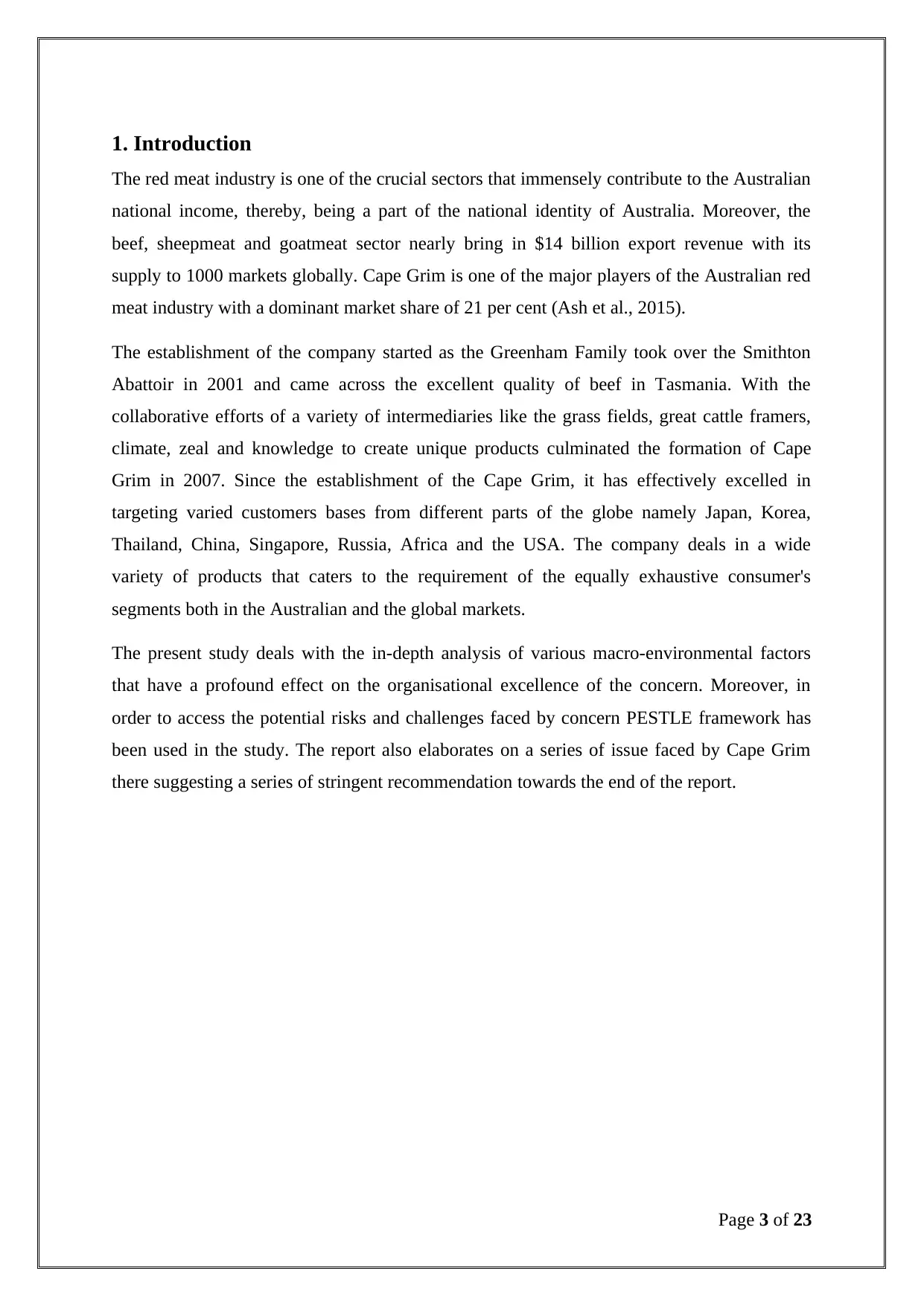
1. Introduction
The red meat industry is one of the crucial sectors that immensely contribute to the Australian
national income, thereby, being a part of the national identity of Australia. Moreover, the
beef, sheepmeat and goatmeat sector nearly bring in $14 billion export revenue with its
supply to 1000 markets globally. Cape Grim is one of the major players of the Australian red
meat industry with a dominant market share of 21 per cent (Ash et al., 2015).
The establishment of the company started as the Greenham Family took over the Smithton
Abattoir in 2001 and came across the excellent quality of beef in Tasmania. With the
collaborative efforts of a variety of intermediaries like the grass fields, great cattle framers,
climate, zeal and knowledge to create unique products culminated the formation of Cape
Grim in 2007. Since the establishment of the Cape Grim, it has effectively excelled in
targeting varied customers bases from different parts of the globe namely Japan, Korea,
Thailand, China, Singapore, Russia, Africa and the USA. The company deals in a wide
variety of products that caters to the requirement of the equally exhaustive consumer's
segments both in the Australian and the global markets.
The present study deals with the in-depth analysis of various macro-environmental factors
that have a profound effect on the organisational excellence of the concern. Moreover, in
order to access the potential risks and challenges faced by concern PESTLE framework has
been used in the study. The report also elaborates on a series of issue faced by Cape Grim
there suggesting a series of stringent recommendation towards the end of the report.
Page 3 of 23
The red meat industry is one of the crucial sectors that immensely contribute to the Australian
national income, thereby, being a part of the national identity of Australia. Moreover, the
beef, sheepmeat and goatmeat sector nearly bring in $14 billion export revenue with its
supply to 1000 markets globally. Cape Grim is one of the major players of the Australian red
meat industry with a dominant market share of 21 per cent (Ash et al., 2015).
The establishment of the company started as the Greenham Family took over the Smithton
Abattoir in 2001 and came across the excellent quality of beef in Tasmania. With the
collaborative efforts of a variety of intermediaries like the grass fields, great cattle framers,
climate, zeal and knowledge to create unique products culminated the formation of Cape
Grim in 2007. Since the establishment of the Cape Grim, it has effectively excelled in
targeting varied customers bases from different parts of the globe namely Japan, Korea,
Thailand, China, Singapore, Russia, Africa and the USA. The company deals in a wide
variety of products that caters to the requirement of the equally exhaustive consumer's
segments both in the Australian and the global markets.
The present study deals with the in-depth analysis of various macro-environmental factors
that have a profound effect on the organisational excellence of the concern. Moreover, in
order to access the potential risks and challenges faced by concern PESTLE framework has
been used in the study. The report also elaborates on a series of issue faced by Cape Grim
there suggesting a series of stringent recommendation towards the end of the report.
Page 3 of 23
Paraphrase This Document
Need a fresh take? Get an instant paraphrase of this document with our AI Paraphraser
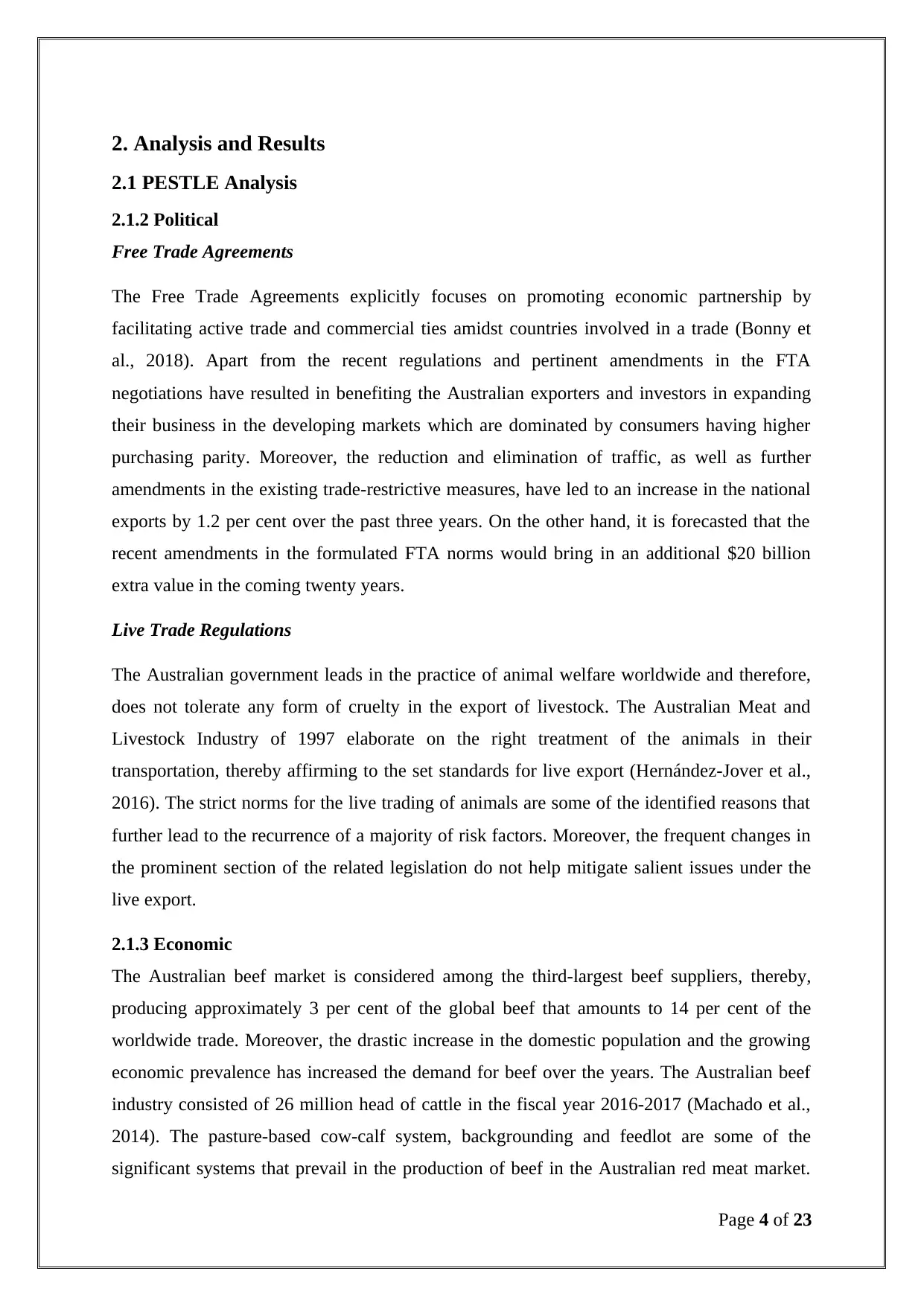
2. Analysis and Results
2.1 PESTLE Analysis
2.1.2 Political
Free Trade Agreements
The Free Trade Agreements explicitly focuses on promoting economic partnership by
facilitating active trade and commercial ties amidst countries involved in a trade (Bonny et
al., 2018). Apart from the recent regulations and pertinent amendments in the FTA
negotiations have resulted in benefiting the Australian exporters and investors in expanding
their business in the developing markets which are dominated by consumers having higher
purchasing parity. Moreover, the reduction and elimination of traffic, as well as further
amendments in the existing trade-restrictive measures, have led to an increase in the national
exports by 1.2 per cent over the past three years. On the other hand, it is forecasted that the
recent amendments in the formulated FTA norms would bring in an additional $20 billion
extra value in the coming twenty years.
Live Trade Regulations
The Australian government leads in the practice of animal welfare worldwide and therefore,
does not tolerate any form of cruelty in the export of livestock. The Australian Meat and
Livestock Industry of 1997 elaborate on the right treatment of the animals in their
transportation, thereby affirming to the set standards for live export (Hernández-Jover et al.,
2016). The strict norms for the live trading of animals are some of the identified reasons that
further lead to the recurrence of a majority of risk factors. Moreover, the frequent changes in
the prominent section of the related legislation do not help mitigate salient issues under the
live export.
2.1.3 Economic
The Australian beef market is considered among the third-largest beef suppliers, thereby,
producing approximately 3 per cent of the global beef that amounts to 14 per cent of the
worldwide trade. Moreover, the drastic increase in the domestic population and the growing
economic prevalence has increased the demand for beef over the years. The Australian beef
industry consisted of 26 million head of cattle in the fiscal year 2016-2017 (Machado et al.,
2014). The pasture-based cow-calf system, backgrounding and feedlot are some of the
significant systems that prevail in the production of beef in the Australian red meat market.
Page 4 of 23
2.1 PESTLE Analysis
2.1.2 Political
Free Trade Agreements
The Free Trade Agreements explicitly focuses on promoting economic partnership by
facilitating active trade and commercial ties amidst countries involved in a trade (Bonny et
al., 2018). Apart from the recent regulations and pertinent amendments in the FTA
negotiations have resulted in benefiting the Australian exporters and investors in expanding
their business in the developing markets which are dominated by consumers having higher
purchasing parity. Moreover, the reduction and elimination of traffic, as well as further
amendments in the existing trade-restrictive measures, have led to an increase in the national
exports by 1.2 per cent over the past three years. On the other hand, it is forecasted that the
recent amendments in the formulated FTA norms would bring in an additional $20 billion
extra value in the coming twenty years.
Live Trade Regulations
The Australian government leads in the practice of animal welfare worldwide and therefore,
does not tolerate any form of cruelty in the export of livestock. The Australian Meat and
Livestock Industry of 1997 elaborate on the right treatment of the animals in their
transportation, thereby affirming to the set standards for live export (Hernández-Jover et al.,
2016). The strict norms for the live trading of animals are some of the identified reasons that
further lead to the recurrence of a majority of risk factors. Moreover, the frequent changes in
the prominent section of the related legislation do not help mitigate salient issues under the
live export.
2.1.3 Economic
The Australian beef market is considered among the third-largest beef suppliers, thereby,
producing approximately 3 per cent of the global beef that amounts to 14 per cent of the
worldwide trade. Moreover, the drastic increase in the domestic population and the growing
economic prevalence has increased the demand for beef over the years. The Australian beef
industry consisted of 26 million head of cattle in the fiscal year 2016-2017 (Machado et al.,
2014). The pasture-based cow-calf system, backgrounding and feedlot are some of the
significant systems that prevail in the production of beef in the Australian red meat market.
Page 4 of 23
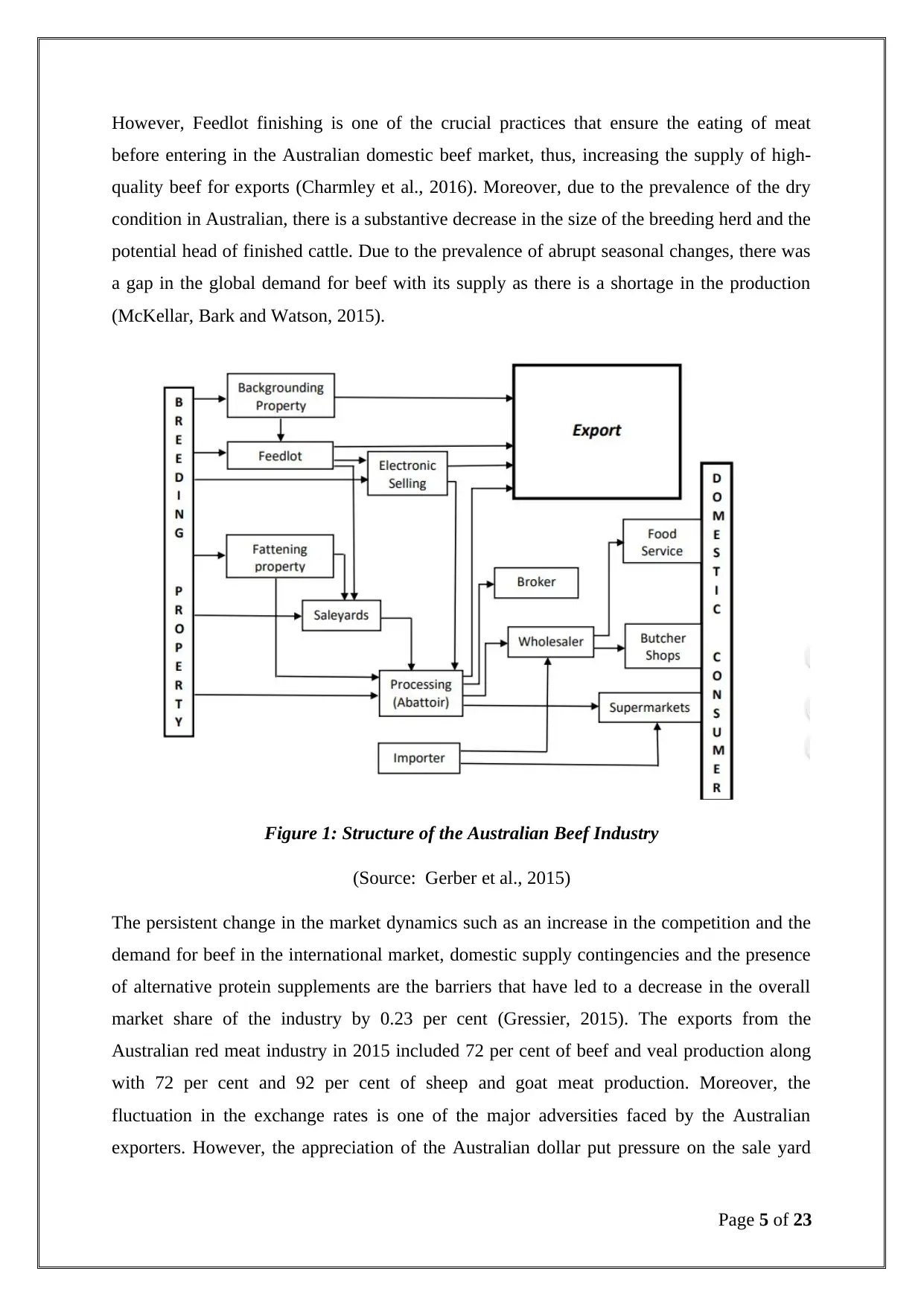
However, Feedlot finishing is one of the crucial practices that ensure the eating of meat
before entering in the Australian domestic beef market, thus, increasing the supply of high-
quality beef for exports (Charmley et al., 2016). Moreover, due to the prevalence of the dry
condition in Australian, there is a substantive decrease in the size of the breeding herd and the
potential head of finished cattle. Due to the prevalence of abrupt seasonal changes, there was
a gap in the global demand for beef with its supply as there is a shortage in the production
(McKellar, Bark and Watson, 2015).
Figure 1: Structure of the Australian Beef Industry
(Source: Gerber et al., 2015)
The persistent change in the market dynamics such as an increase in the competition and the
demand for beef in the international market, domestic supply contingencies and the presence
of alternative protein supplements are the barriers that have led to a decrease in the overall
market share of the industry by 0.23 per cent (Gressier, 2015). The exports from the
Australian red meat industry in 2015 included 72 per cent of beef and veal production along
with 72 per cent and 92 per cent of sheep and goat meat production. Moreover, the
fluctuation in the exchange rates is one of the major adversities faced by the Australian
exporters. However, the appreciation of the Australian dollar put pressure on the sale yard
Page 5 of 23
before entering in the Australian domestic beef market, thus, increasing the supply of high-
quality beef for exports (Charmley et al., 2016). Moreover, due to the prevalence of the dry
condition in Australian, there is a substantive decrease in the size of the breeding herd and the
potential head of finished cattle. Due to the prevalence of abrupt seasonal changes, there was
a gap in the global demand for beef with its supply as there is a shortage in the production
(McKellar, Bark and Watson, 2015).
Figure 1: Structure of the Australian Beef Industry
(Source: Gerber et al., 2015)
The persistent change in the market dynamics such as an increase in the competition and the
demand for beef in the international market, domestic supply contingencies and the presence
of alternative protein supplements are the barriers that have led to a decrease in the overall
market share of the industry by 0.23 per cent (Gressier, 2015). The exports from the
Australian red meat industry in 2015 included 72 per cent of beef and veal production along
with 72 per cent and 92 per cent of sheep and goat meat production. Moreover, the
fluctuation in the exchange rates is one of the major adversities faced by the Australian
exporters. However, the appreciation of the Australian dollar put pressure on the sale yard
Page 5 of 23
⊘ This is a preview!⊘
Do you want full access?
Subscribe today to unlock all pages.

Trusted by 1+ million students worldwide
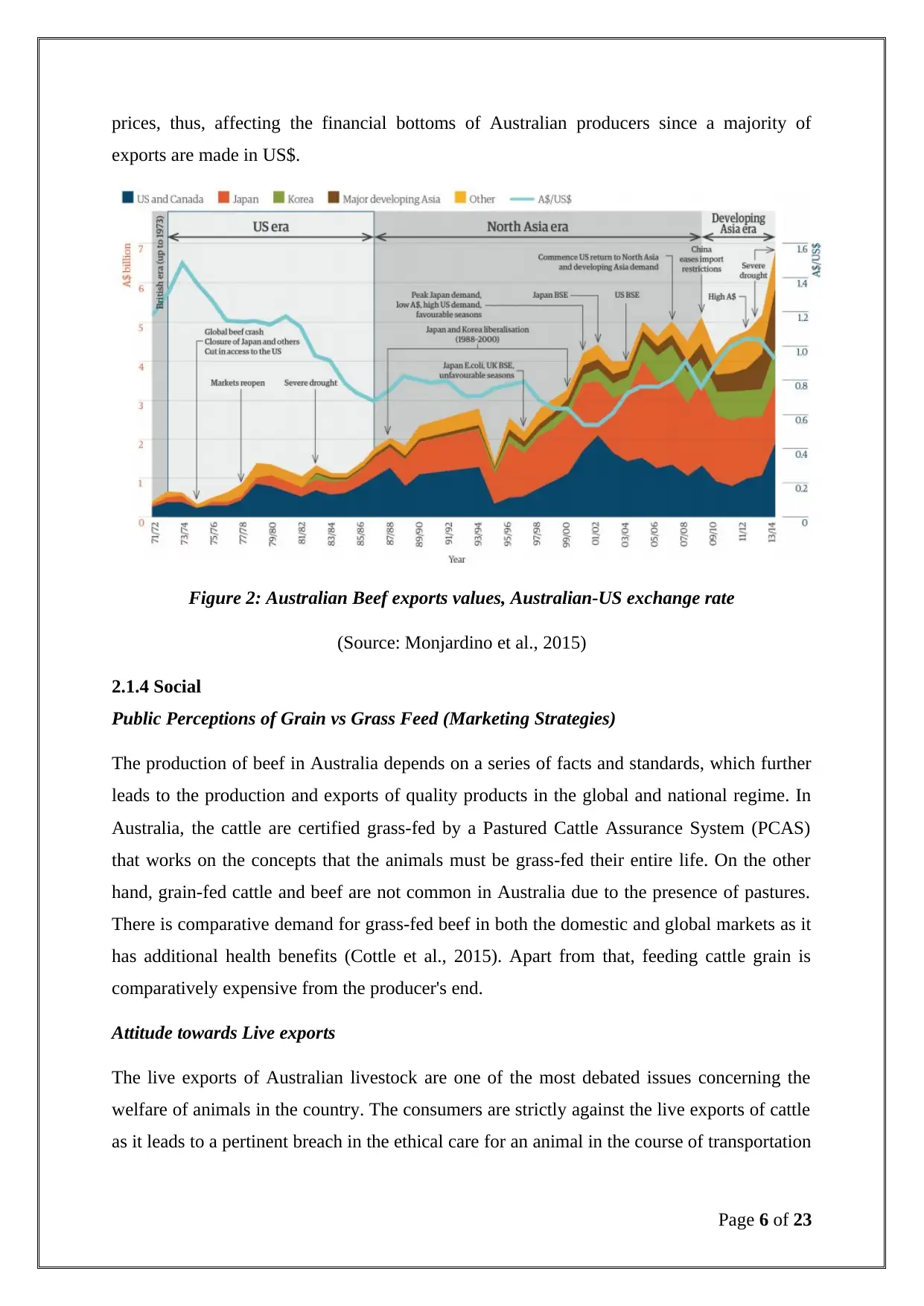
prices, thus, affecting the financial bottoms of Australian producers since a majority of
exports are made in US$.
Figure 2: Australian Beef exports values, Australian-US exchange rate
(Source: Monjardino et al., 2015)
2.1.4 Social
Public Perceptions of Grain vs Grass Feed (Marketing Strategies)
The production of beef in Australia depends on a series of facts and standards, which further
leads to the production and exports of quality products in the global and national regime. In
Australia, the cattle are certified grass-fed by a Pastured Cattle Assurance System (PCAS)
that works on the concepts that the animals must be grass-fed their entire life. On the other
hand, grain-fed cattle and beef are not common in Australia due to the presence of pastures.
There is comparative demand for grass-fed beef in both the domestic and global markets as it
has additional health benefits (Cottle et al., 2015). Apart from that, feeding cattle grain is
comparatively expensive from the producer's end.
Attitude towards Live exports
The live exports of Australian livestock are one of the most debated issues concerning the
welfare of animals in the country. The consumers are strictly against the live exports of cattle
as it leads to a pertinent breach in the ethical care for an animal in the course of transportation
Page 6 of 23
exports are made in US$.
Figure 2: Australian Beef exports values, Australian-US exchange rate
(Source: Monjardino et al., 2015)
2.1.4 Social
Public Perceptions of Grain vs Grass Feed (Marketing Strategies)
The production of beef in Australia depends on a series of facts and standards, which further
leads to the production and exports of quality products in the global and national regime. In
Australia, the cattle are certified grass-fed by a Pastured Cattle Assurance System (PCAS)
that works on the concepts that the animals must be grass-fed their entire life. On the other
hand, grain-fed cattle and beef are not common in Australia due to the presence of pastures.
There is comparative demand for grass-fed beef in both the domestic and global markets as it
has additional health benefits (Cottle et al., 2015). Apart from that, feeding cattle grain is
comparatively expensive from the producer's end.
Attitude towards Live exports
The live exports of Australian livestock are one of the most debated issues concerning the
welfare of animals in the country. The consumers are strictly against the live exports of cattle
as it leads to a pertinent breach in the ethical care for an animal in the course of transportation
Page 6 of 23
Paraphrase This Document
Need a fresh take? Get an instant paraphrase of this document with our AI Paraphraser
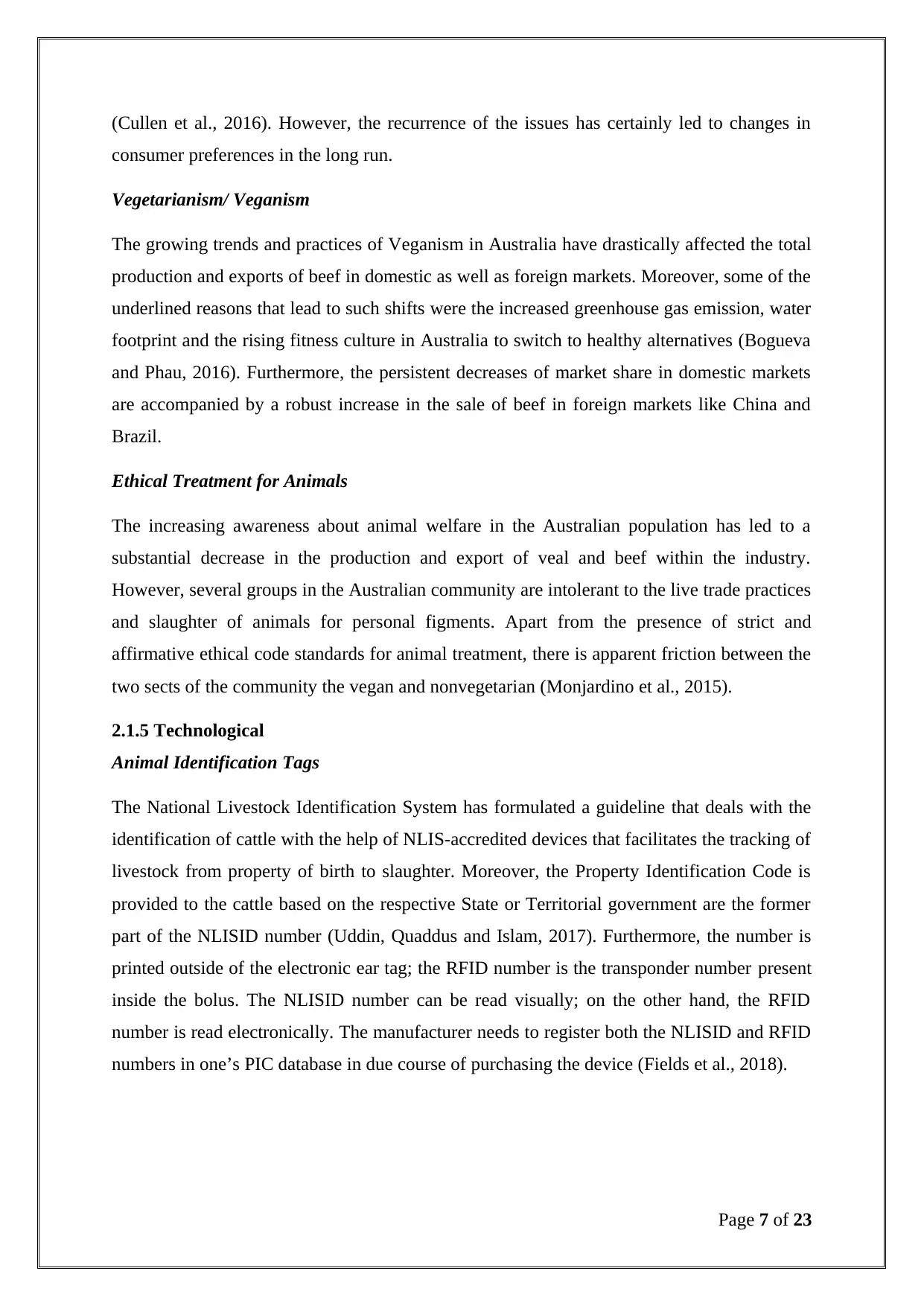
(Cullen et al., 2016). However, the recurrence of the issues has certainly led to changes in
consumer preferences in the long run.
Vegetarianism/ Veganism
The growing trends and practices of Veganism in Australia have drastically affected the total
production and exports of beef in domestic as well as foreign markets. Moreover, some of the
underlined reasons that lead to such shifts were the increased greenhouse gas emission, water
footprint and the rising fitness culture in Australia to switch to healthy alternatives (Bogueva
and Phau, 2016). Furthermore, the persistent decreases of market share in domestic markets
are accompanied by a robust increase in the sale of beef in foreign markets like China and
Brazil.
Ethical Treatment for Animals
The increasing awareness about animal welfare in the Australian population has led to a
substantial decrease in the production and export of veal and beef within the industry.
However, several groups in the Australian community are intolerant to the live trade practices
and slaughter of animals for personal figments. Apart from the presence of strict and
affirmative ethical code standards for animal treatment, there is apparent friction between the
two sects of the community the vegan and nonvegetarian (Monjardino et al., 2015).
2.1.5 Technological
Animal Identification Tags
The National Livestock Identification System has formulated a guideline that deals with the
identification of cattle with the help of NLIS-accredited devices that facilitates the tracking of
livestock from property of birth to slaughter. Moreover, the Property Identification Code is
provided to the cattle based on the respective State or Territorial government are the former
part of the NLISID number (Uddin, Quaddus and Islam, 2017). Furthermore, the number is
printed outside of the electronic ear tag; the RFID number is the transponder number present
inside the bolus. The NLISID number can be read visually; on the other hand, the RFID
number is read electronically. The manufacturer needs to register both the NLISID and RFID
numbers in one’s PIC database in due course of purchasing the device (Fields et al., 2018).
Page 7 of 23
consumer preferences in the long run.
Vegetarianism/ Veganism
The growing trends and practices of Veganism in Australia have drastically affected the total
production and exports of beef in domestic as well as foreign markets. Moreover, some of the
underlined reasons that lead to such shifts were the increased greenhouse gas emission, water
footprint and the rising fitness culture in Australia to switch to healthy alternatives (Bogueva
and Phau, 2016). Furthermore, the persistent decreases of market share in domestic markets
are accompanied by a robust increase in the sale of beef in foreign markets like China and
Brazil.
Ethical Treatment for Animals
The increasing awareness about animal welfare in the Australian population has led to a
substantial decrease in the production and export of veal and beef within the industry.
However, several groups in the Australian community are intolerant to the live trade practices
and slaughter of animals for personal figments. Apart from the presence of strict and
affirmative ethical code standards for animal treatment, there is apparent friction between the
two sects of the community the vegan and nonvegetarian (Monjardino et al., 2015).
2.1.5 Technological
Animal Identification Tags
The National Livestock Identification System has formulated a guideline that deals with the
identification of cattle with the help of NLIS-accredited devices that facilitates the tracking of
livestock from property of birth to slaughter. Moreover, the Property Identification Code is
provided to the cattle based on the respective State or Territorial government are the former
part of the NLISID number (Uddin, Quaddus and Islam, 2017). Furthermore, the number is
printed outside of the electronic ear tag; the RFID number is the transponder number present
inside the bolus. The NLISID number can be read visually; on the other hand, the RFID
number is read electronically. The manufacturer needs to register both the NLISID and RFID
numbers in one’s PIC database in due course of purchasing the device (Fields et al., 2018).
Page 7 of 23
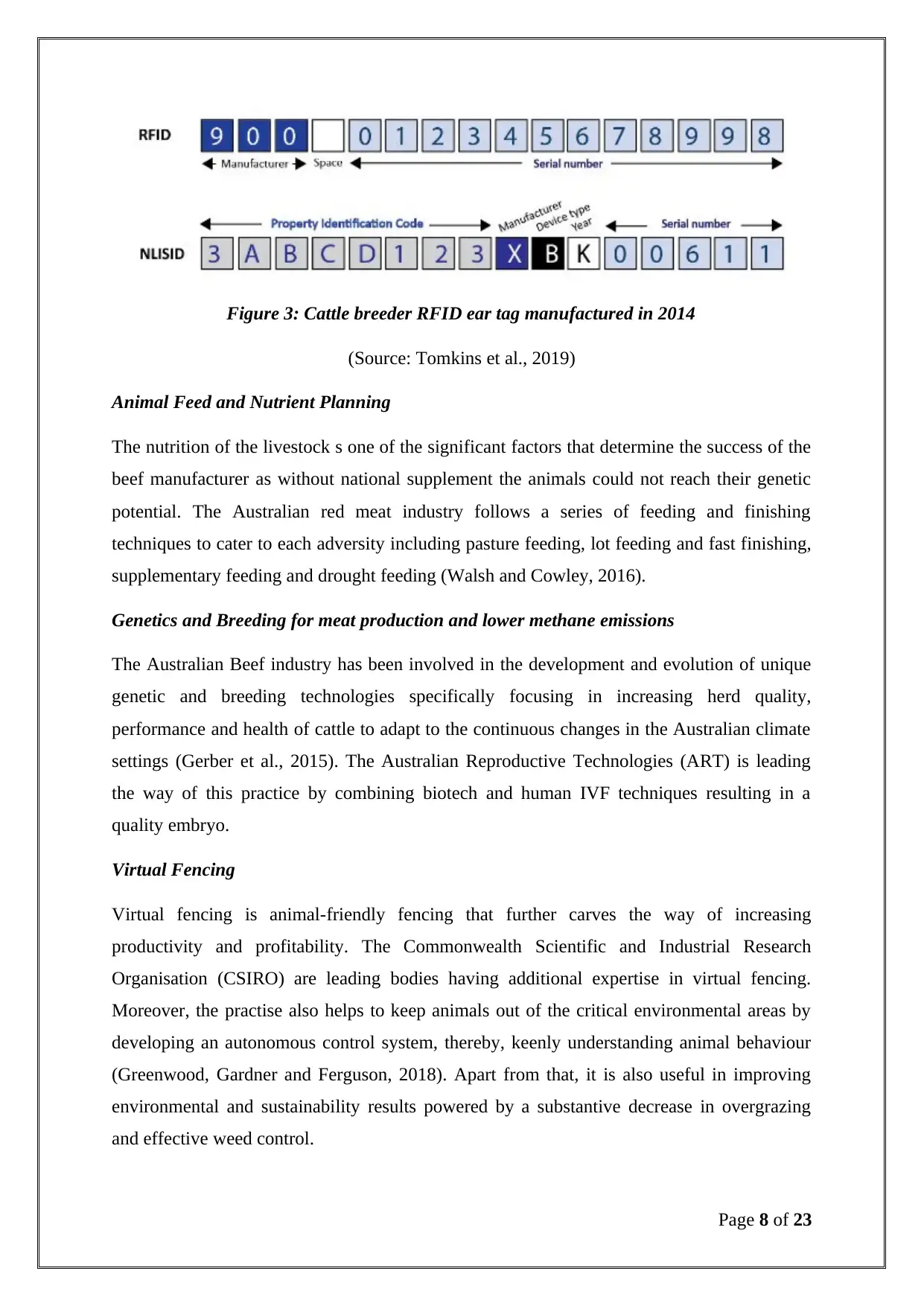
Figure 3: Cattle breeder RFID ear tag manufactured in 2014
(Source: Tomkins et al., 2019)
Animal Feed and Nutrient Planning
The nutrition of the livestock s one of the significant factors that determine the success of the
beef manufacturer as without national supplement the animals could not reach their genetic
potential. The Australian red meat industry follows a series of feeding and finishing
techniques to cater to each adversity including pasture feeding, lot feeding and fast finishing,
supplementary feeding and drought feeding (Walsh and Cowley, 2016).
Genetics and Breeding for meat production and lower methane emissions
The Australian Beef industry has been involved in the development and evolution of unique
genetic and breeding technologies specifically focusing in increasing herd quality,
performance and health of cattle to adapt to the continuous changes in the Australian climate
settings (Gerber et al., 2015). The Australian Reproductive Technologies (ART) is leading
the way of this practice by combining biotech and human IVF techniques resulting in a
quality embryo.
Virtual Fencing
Virtual fencing is animal-friendly fencing that further carves the way of increasing
productivity and profitability. The Commonwealth Scientific and Industrial Research
Organisation (CSIRO) are leading bodies having additional expertise in virtual fencing.
Moreover, the practise also helps to keep animals out of the critical environmental areas by
developing an autonomous control system, thereby, keenly understanding animal behaviour
(Greenwood, Gardner and Ferguson, 2018). Apart from that, it is also useful in improving
environmental and sustainability results powered by a substantive decrease in overgrazing
and effective weed control.
Page 8 of 23
(Source: Tomkins et al., 2019)
Animal Feed and Nutrient Planning
The nutrition of the livestock s one of the significant factors that determine the success of the
beef manufacturer as without national supplement the animals could not reach their genetic
potential. The Australian red meat industry follows a series of feeding and finishing
techniques to cater to each adversity including pasture feeding, lot feeding and fast finishing,
supplementary feeding and drought feeding (Walsh and Cowley, 2016).
Genetics and Breeding for meat production and lower methane emissions
The Australian Beef industry has been involved in the development and evolution of unique
genetic and breeding technologies specifically focusing in increasing herd quality,
performance and health of cattle to adapt to the continuous changes in the Australian climate
settings (Gerber et al., 2015). The Australian Reproductive Technologies (ART) is leading
the way of this practice by combining biotech and human IVF techniques resulting in a
quality embryo.
Virtual Fencing
Virtual fencing is animal-friendly fencing that further carves the way of increasing
productivity and profitability. The Commonwealth Scientific and Industrial Research
Organisation (CSIRO) are leading bodies having additional expertise in virtual fencing.
Moreover, the practise also helps to keep animals out of the critical environmental areas by
developing an autonomous control system, thereby, keenly understanding animal behaviour
(Greenwood, Gardner and Ferguson, 2018). Apart from that, it is also useful in improving
environmental and sustainability results powered by a substantive decrease in overgrazing
and effective weed control.
Page 8 of 23
⊘ This is a preview!⊘
Do you want full access?
Subscribe today to unlock all pages.

Trusted by 1+ million students worldwide
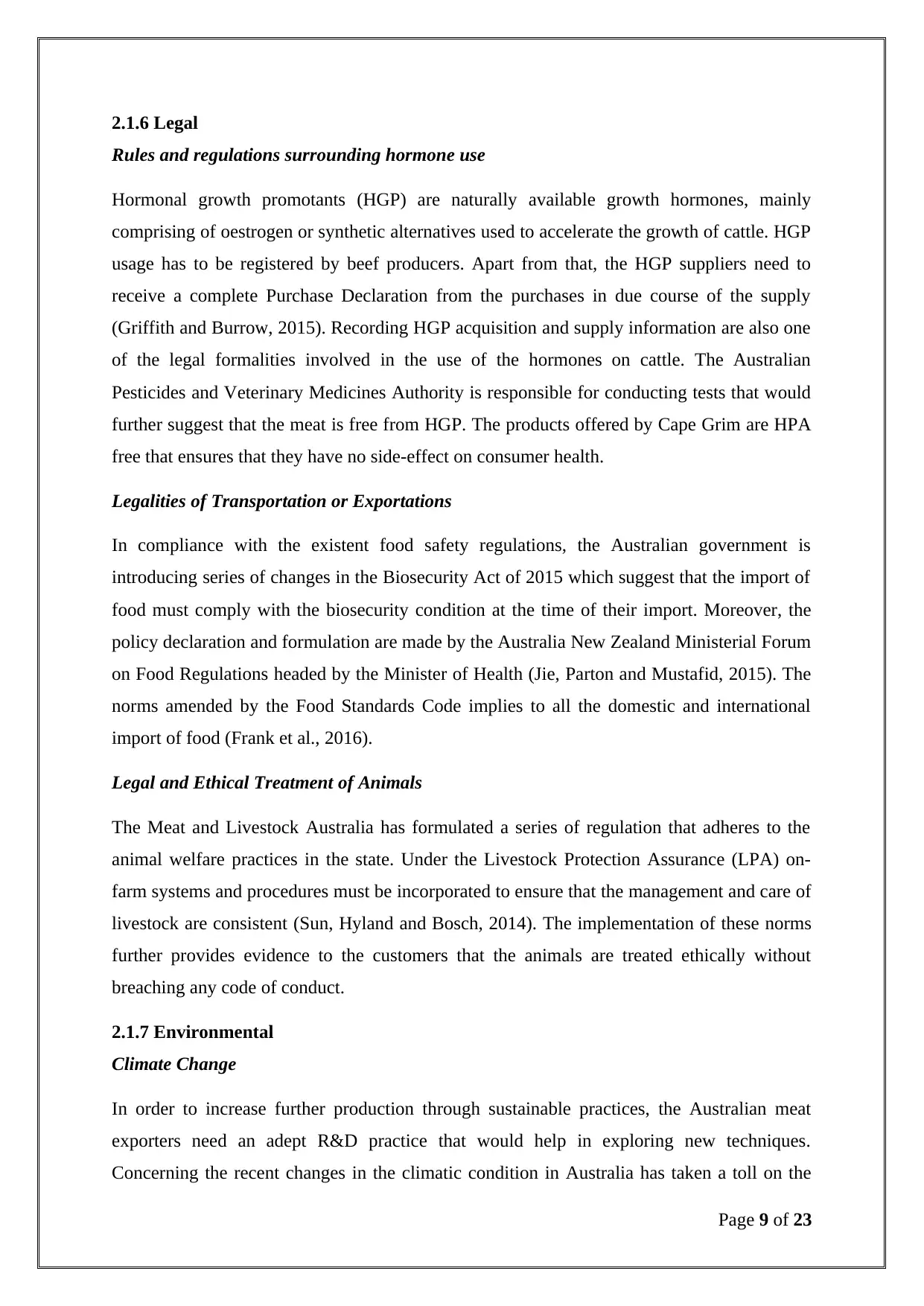
2.1.6 Legal
Rules and regulations surrounding hormone use
Hormonal growth promotants (HGP) are naturally available growth hormones, mainly
comprising of oestrogen or synthetic alternatives used to accelerate the growth of cattle. HGP
usage has to be registered by beef producers. Apart from that, the HGP suppliers need to
receive a complete Purchase Declaration from the purchases in due course of the supply
(Griffith and Burrow, 2015). Recording HGP acquisition and supply information are also one
of the legal formalities involved in the use of the hormones on cattle. The Australian
Pesticides and Veterinary Medicines Authority is responsible for conducting tests that would
further suggest that the meat is free from HGP. The products offered by Cape Grim are HPA
free that ensures that they have no side-effect on consumer health.
Legalities of Transportation or Exportations
In compliance with the existent food safety regulations, the Australian government is
introducing series of changes in the Biosecurity Act of 2015 which suggest that the import of
food must comply with the biosecurity condition at the time of their import. Moreover, the
policy declaration and formulation are made by the Australia New Zealand Ministerial Forum
on Food Regulations headed by the Minister of Health (Jie, Parton and Mustafid, 2015). The
norms amended by the Food Standards Code implies to all the domestic and international
import of food (Frank et al., 2016).
Legal and Ethical Treatment of Animals
The Meat and Livestock Australia has formulated a series of regulation that adheres to the
animal welfare practices in the state. Under the Livestock Protection Assurance (LPA) on-
farm systems and procedures must be incorporated to ensure that the management and care of
livestock are consistent (Sun, Hyland and Bosch, 2014). The implementation of these norms
further provides evidence to the customers that the animals are treated ethically without
breaching any code of conduct.
2.1.7 Environmental
Climate Change
In order to increase further production through sustainable practices, the Australian meat
exporters need an adept R&D practice that would help in exploring new techniques.
Concerning the recent changes in the climatic condition in Australia has taken a toll on the
Page 9 of 23
Rules and regulations surrounding hormone use
Hormonal growth promotants (HGP) are naturally available growth hormones, mainly
comprising of oestrogen or synthetic alternatives used to accelerate the growth of cattle. HGP
usage has to be registered by beef producers. Apart from that, the HGP suppliers need to
receive a complete Purchase Declaration from the purchases in due course of the supply
(Griffith and Burrow, 2015). Recording HGP acquisition and supply information are also one
of the legal formalities involved in the use of the hormones on cattle. The Australian
Pesticides and Veterinary Medicines Authority is responsible for conducting tests that would
further suggest that the meat is free from HGP. The products offered by Cape Grim are HPA
free that ensures that they have no side-effect on consumer health.
Legalities of Transportation or Exportations
In compliance with the existent food safety regulations, the Australian government is
introducing series of changes in the Biosecurity Act of 2015 which suggest that the import of
food must comply with the biosecurity condition at the time of their import. Moreover, the
policy declaration and formulation are made by the Australia New Zealand Ministerial Forum
on Food Regulations headed by the Minister of Health (Jie, Parton and Mustafid, 2015). The
norms amended by the Food Standards Code implies to all the domestic and international
import of food (Frank et al., 2016).
Legal and Ethical Treatment of Animals
The Meat and Livestock Australia has formulated a series of regulation that adheres to the
animal welfare practices in the state. Under the Livestock Protection Assurance (LPA) on-
farm systems and procedures must be incorporated to ensure that the management and care of
livestock are consistent (Sun, Hyland and Bosch, 2014). The implementation of these norms
further provides evidence to the customers that the animals are treated ethically without
breaching any code of conduct.
2.1.7 Environmental
Climate Change
In order to increase further production through sustainable practices, the Australian meat
exporters need an adept R&D practice that would help in exploring new techniques.
Concerning the recent changes in the climatic condition in Australia has taken a toll on the
Page 9 of 23
Paraphrase This Document
Need a fresh take? Get an instant paraphrase of this document with our AI Paraphraser
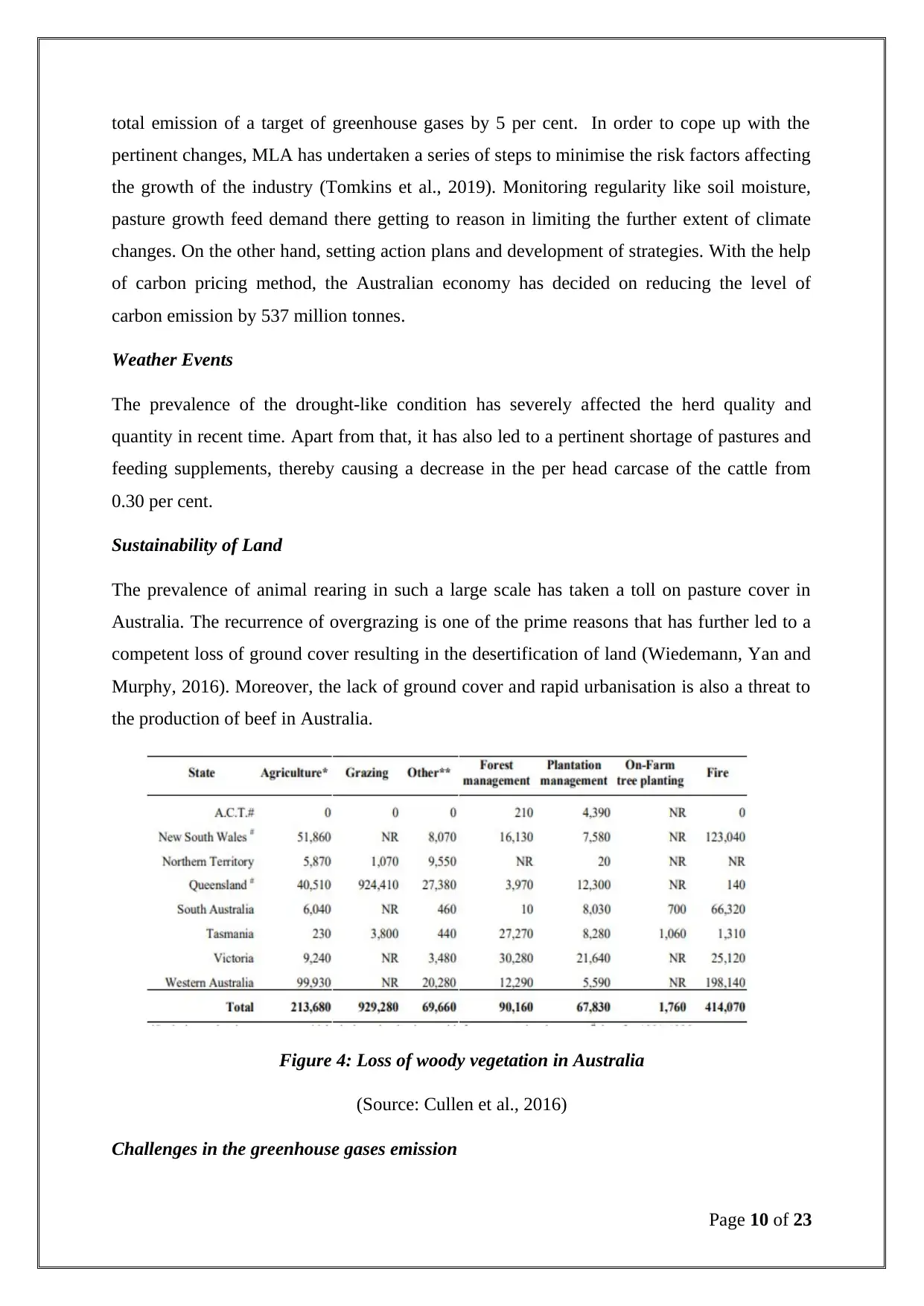
total emission of a target of greenhouse gases by 5 per cent. In order to cope up with the
pertinent changes, MLA has undertaken a series of steps to minimise the risk factors affecting
the growth of the industry (Tomkins et al., 2019). Monitoring regularity like soil moisture,
pasture growth feed demand there getting to reason in limiting the further extent of climate
changes. On the other hand, setting action plans and development of strategies. With the help
of carbon pricing method, the Australian economy has decided on reducing the level of
carbon emission by 537 million tonnes.
Weather Events
The prevalence of the drought-like condition has severely affected the herd quality and
quantity in recent time. Apart from that, it has also led to a pertinent shortage of pastures and
feeding supplements, thereby causing a decrease in the per head carcase of the cattle from
0.30 per cent.
Sustainability of Land
The prevalence of animal rearing in such a large scale has taken a toll on pasture cover in
Australia. The recurrence of overgrazing is one of the prime reasons that has further led to a
competent loss of ground cover resulting in the desertification of land (Wiedemann, Yan and
Murphy, 2016). Moreover, the lack of ground cover and rapid urbanisation is also a threat to
the production of beef in Australia.
Figure 4: Loss of woody vegetation in Australia
(Source: Cullen et al., 2016)
Challenges in the greenhouse gases emission
Page 10 of 23
pertinent changes, MLA has undertaken a series of steps to minimise the risk factors affecting
the growth of the industry (Tomkins et al., 2019). Monitoring regularity like soil moisture,
pasture growth feed demand there getting to reason in limiting the further extent of climate
changes. On the other hand, setting action plans and development of strategies. With the help
of carbon pricing method, the Australian economy has decided on reducing the level of
carbon emission by 537 million tonnes.
Weather Events
The prevalence of the drought-like condition has severely affected the herd quality and
quantity in recent time. Apart from that, it has also led to a pertinent shortage of pastures and
feeding supplements, thereby causing a decrease in the per head carcase of the cattle from
0.30 per cent.
Sustainability of Land
The prevalence of animal rearing in such a large scale has taken a toll on pasture cover in
Australia. The recurrence of overgrazing is one of the prime reasons that has further led to a
competent loss of ground cover resulting in the desertification of land (Wiedemann, Yan and
Murphy, 2016). Moreover, the lack of ground cover and rapid urbanisation is also a threat to
the production of beef in Australia.
Figure 4: Loss of woody vegetation in Australia
(Source: Cullen et al., 2016)
Challenges in the greenhouse gases emission
Page 10 of 23
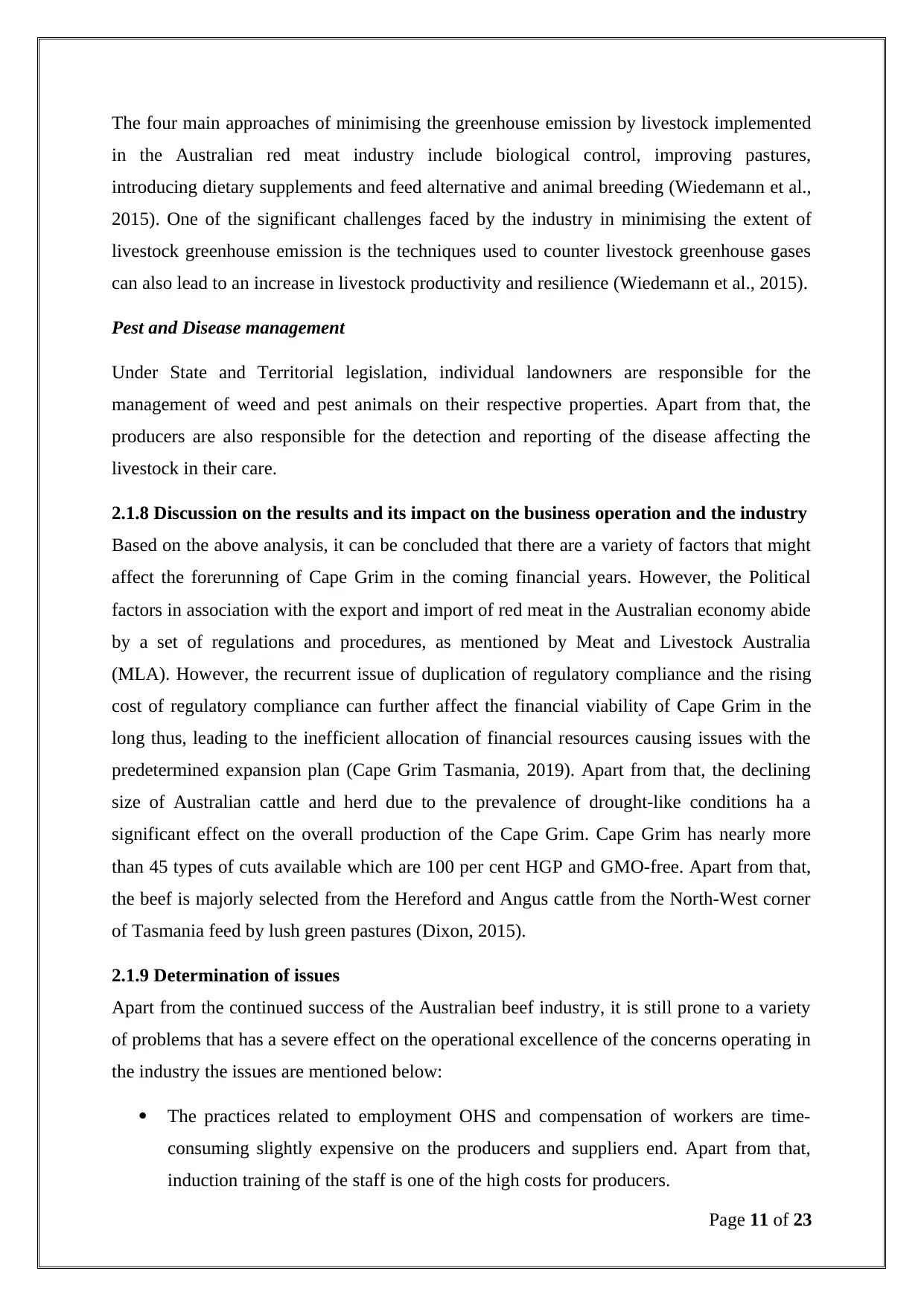
The four main approaches of minimising the greenhouse emission by livestock implemented
in the Australian red meat industry include biological control, improving pastures,
introducing dietary supplements and feed alternative and animal breeding (Wiedemann et al.,
2015). One of the significant challenges faced by the industry in minimising the extent of
livestock greenhouse emission is the techniques used to counter livestock greenhouse gases
can also lead to an increase in livestock productivity and resilience (Wiedemann et al., 2015).
Pest and Disease management
Under State and Territorial legislation, individual landowners are responsible for the
management of weed and pest animals on their respective properties. Apart from that, the
producers are also responsible for the detection and reporting of the disease affecting the
livestock in their care.
2.1.8 Discussion on the results and its impact on the business operation and the industry
Based on the above analysis, it can be concluded that there are a variety of factors that might
affect the forerunning of Cape Grim in the coming financial years. However, the Political
factors in association with the export and import of red meat in the Australian economy abide
by a set of regulations and procedures, as mentioned by Meat and Livestock Australia
(MLA). However, the recurrent issue of duplication of regulatory compliance and the rising
cost of regulatory compliance can further affect the financial viability of Cape Grim in the
long thus, leading to the inefficient allocation of financial resources causing issues with the
predetermined expansion plan (Cape Grim Tasmania, 2019). Apart from that, the declining
size of Australian cattle and herd due to the prevalence of drought-like conditions ha a
significant effect on the overall production of the Cape Grim. Cape Grim has nearly more
than 45 types of cuts available which are 100 per cent HGP and GMO-free. Apart from that,
the beef is majorly selected from the Hereford and Angus cattle from the North-West corner
of Tasmania feed by lush green pastures (Dixon, 2015).
2.1.9 Determination of issues
Apart from the continued success of the Australian beef industry, it is still prone to a variety
of problems that has a severe effect on the operational excellence of the concerns operating in
the industry the issues are mentioned below:
The practices related to employment OHS and compensation of workers are time-
consuming slightly expensive on the producers and suppliers end. Apart from that,
induction training of the staff is one of the high costs for producers.
Page 11 of 23
in the Australian red meat industry include biological control, improving pastures,
introducing dietary supplements and feed alternative and animal breeding (Wiedemann et al.,
2015). One of the significant challenges faced by the industry in minimising the extent of
livestock greenhouse emission is the techniques used to counter livestock greenhouse gases
can also lead to an increase in livestock productivity and resilience (Wiedemann et al., 2015).
Pest and Disease management
Under State and Territorial legislation, individual landowners are responsible for the
management of weed and pest animals on their respective properties. Apart from that, the
producers are also responsible for the detection and reporting of the disease affecting the
livestock in their care.
2.1.8 Discussion on the results and its impact on the business operation and the industry
Based on the above analysis, it can be concluded that there are a variety of factors that might
affect the forerunning of Cape Grim in the coming financial years. However, the Political
factors in association with the export and import of red meat in the Australian economy abide
by a set of regulations and procedures, as mentioned by Meat and Livestock Australia
(MLA). However, the recurrent issue of duplication of regulatory compliance and the rising
cost of regulatory compliance can further affect the financial viability of Cape Grim in the
long thus, leading to the inefficient allocation of financial resources causing issues with the
predetermined expansion plan (Cape Grim Tasmania, 2019). Apart from that, the declining
size of Australian cattle and herd due to the prevalence of drought-like conditions ha a
significant effect on the overall production of the Cape Grim. Cape Grim has nearly more
than 45 types of cuts available which are 100 per cent HGP and GMO-free. Apart from that,
the beef is majorly selected from the Hereford and Angus cattle from the North-West corner
of Tasmania feed by lush green pastures (Dixon, 2015).
2.1.9 Determination of issues
Apart from the continued success of the Australian beef industry, it is still prone to a variety
of problems that has a severe effect on the operational excellence of the concerns operating in
the industry the issues are mentioned below:
The practices related to employment OHS and compensation of workers are time-
consuming slightly expensive on the producers and suppliers end. Apart from that,
induction training of the staff is one of the high costs for producers.
Page 11 of 23
⊘ This is a preview!⊘
Do you want full access?
Subscribe today to unlock all pages.

Trusted by 1+ million students worldwide
1 out of 23
Related Documents
Your All-in-One AI-Powered Toolkit for Academic Success.
+13062052269
info@desklib.com
Available 24*7 on WhatsApp / Email
![[object Object]](/_next/static/media/star-bottom.7253800d.svg)
Unlock your academic potential
Copyright © 2020–2025 A2Z Services. All Rights Reserved. Developed and managed by ZUCOL.




